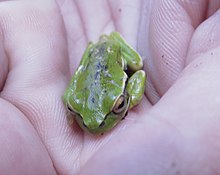
Boana is a genus of frogs in the family Hylidae. They are commonly known as gladiator frogs, gladiator treefrogs or Wagler Neotropical treefrogs. These frogs are distributed in the tropical Central and South America from Nicaragua to Argentina, as well as in the Caribbean.

The white-black tree frog is a species of frog in the family Hylidae endemic to Bolivia. Its natural habitats are subtropical or tropical moist montane forests, subtropical or tropical high-altitude shrubland, subtropical or tropical high-altitude grassland, and rivers. It is threatened by habitat loss.
The Cagua tree frog is a species of frog in the family Hylidae endemic to Venezuela. Its natural habitats are subtropical or tropical moist lowland forests, rivers, freshwater marshes, and intermittent freshwater marshes. It is threatened by habitat loss.
Boana beckeri is a species of frog in the family Hylidae. It is endemic to Brazil and is only known from a handful of localities in southern Minas Gerais and adjacent northeastern São Paulo. The specific name beckeri honors Johann Becker, Brazilian zoologist who collected many of the types.

Troschel's treefrog, also known as the blue-flanked treefrog or the convict treefrog, is a species of frog in the family Hylidae. It is found in most parts of the Amazon Basin including Suriname. Colombian, Guianan and Venezuelan records need confirmation.

The Charuplaya tree frog is a species of frog in the family Hylidae endemic to Bolivia. Its natural habitats are subtropical or tropical moist montane forests, rivers, and canals and ditches.
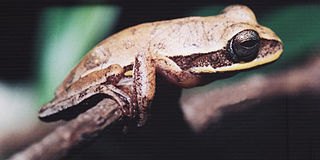
Boana ericae is a species of frog in the family Hylidae. It is endemic to Brazil and only known from its type locality, Chapada dos Veadeiros National Park in the Goiás state. The specific name ericae honors Erica Maria Pellegrini Caramaschi, a Brazilian ichthyologist.

Boana exastis is a species of frog in the family Hylidae. It is endemic to the Northeast Region of Brazil and has been recorded from Bahia, Alagoas, and Pernambuco.
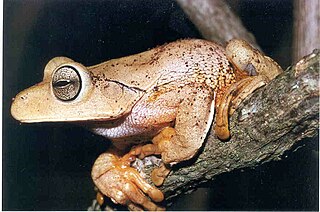
The blacksmith tree frog, or smith frog, is a frog species in the family Hylidae. It is found in eastern to southern Brazil, north-eastern Argentina and south-eastern Paraguay. Its natural habitats are tropical humid forests, including forest edges, at elevations of 150–800 m (490–2,620 ft) above sea level. Breeding takes place in temporary and permanent pools and slow-moving streams where the frogs make nests.

Gunther's banded tree frog is a species of frog in the family Hylidae. The species was re-delimited in 2014 and the most of the earlier records assigned to this species refer to Boana maculateralis, Boana alfaroi, Boana tetete, and possibly also to an unnamed species. It is known with certainty only from the upper and lower montane forests on the western edge of the Amazon Basin in Ecuador and Peru, at elevations of 730–1,530 m (2,400–5,020 ft) above sea level.

The Los Bracitos tree frog, or Hispaniolan green treefrog, is a species of frog in the family Hylidae endemic to Hispaniola and found below 1,856 m (6,089 ft) asl. The species was named in honour of professor Angelo Heilprin who funded the expedition that this species was discovered on.
Boana latistriata is a species of frog in the family Hylidae. It is endemic to Brazil and only known from its type locality, Itatiaia National Park, and from Marmelópolis, both in the state of Minas Gerais. The specific name latistriata refers to the wide stripes on the back of this frog.
The Lema tree frog is a species of frog in the family Hylidae found in Guyana, Venezuela, and possibly Brazil. Its natural habitats are subtropical or tropical moist lowland forests, subtropical or tropical moist montane forests, rivers, pastureland, rural gardens, heavily degraded former forests, aquaculture ponds, and canals and ditches. It is threatened by habitat loss.
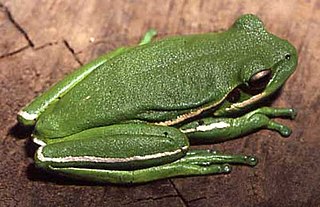
Boana prasina is a species of frog in the family Hylidae. It is endemic to southeastern Brazil and is observed in many Brazilian states: Minas Gerais, Rio de Janeiro, and São Paulo, and possibly further south. The common name of Boana prasina is Burmeister's treefrog.

The polka-dot tree frog, also known as the dotted tree frog, is a frog species in the family Hylidae found in much of South America and also in Trinidad and Tobago. It is fairly small with a snout–to–vent length of c. 3–4 cm (1.2–1.6 in).
Boana rhythmica is a species of frog in the family Hylidae. It is endemic to Venezuela and only known from its type locality, Cerro Jaua in Bolívar State. It occurs along streams on the slopes of the tepui. It is a nocturnal species found on branches of vegetation 0.3–1 m (1–3 ft) above the ground. The tepui is within the Jaua-Sarisariñama National Park, and no major threats to this species have been identified.
Hoogmoed's tree frog is a species of frog in the family Hylidae found in Guyana, possibly Brazil, and possibly Venezuela. Its natural habitats are subtropical or tropical moist montane forests and rivers.
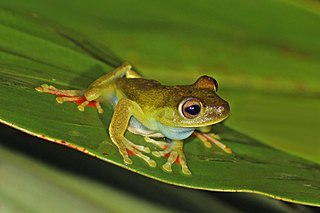
The Canal Zone tree frog is a species of frog in the family Hylidae found in the Caribbean lowlands of eastern Nicaragua, Costa Rica, and central Panama, as well as the Pacific lowlands of Colombia, although the latter records are uncertain and may refer to Boana rosenbergi.

Boana pugnax, the Chirique-Flusse tree frog, is a frog in the family Hylidae. It is endemic to Panama, Colombia, and Venezuela. Scientists have seen it as high as 500 meters above sea level.

Boana gladiator, the Cusco gladiator tree frog, is a frog in the family Hylidae endemic to Peru, in Cusco and Puno. Scientists have seen it between 1,097 and 1,975 metres above sea level in cloud forests.
